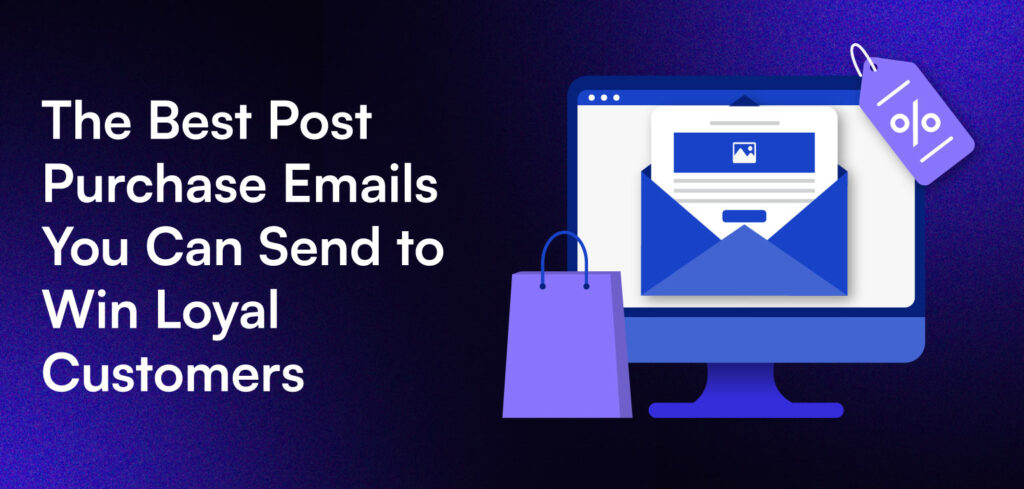If you think the customer journey ends at checkout, you miss the best part. A purchase is just the beginning of the relationship, and what you do next can make or break your chances of turning a one-time buyer into a lifelong fan. That’s where post purchase emails come in.
These aren’t just boring order confirmations or shipping alerts. Done right, they continue the conversation, add value, and keep your brand in mind long after the sale.
In this guide, we’re diving into the best post purchase emails you can send and why each one plays a crucial role in building trust, increasing retention, and encouraging repeat business.
Let’s get into it.
Why Post Purchase Emails Matter More Than You Think
It’s easy to treat post purchase emails as a checklist: order confirmed, item shipped, done. But smart brands know this is a golden window of opportunity.
Here’s why these emails matter more than most think:
- Post purchase emails are your chance to reinforce the customer’s decision and guide them through the rest of their experience with you.
- You stay top of mind. After the sale, customers are more engaged than ever. They’re checking for updates, scanning their inbox, and thinking about your brand. It’s the perfect time to show up consistently.
- You reduce buyer’s remorse. A well-timed “thank you” or a helpful how-to email can erase doubts and create confidence in your brand.
- You build real trust. Transparency around shipping, follow-ups on usage, and genuine care in the tone of your messaging go a long way in making people feel like they’re not just a transaction.
- You increase lifetime value. Happy customers come back. And with the right follow-up emails in place, you’re not just boosting loyalty; you’re setting the stage for referrals, upsells, and long-term retention.
Pro tip: Think of your post purchase flow as onboarding for your brand. The goal is to welcome them into your ecosystem, not just confirm their order.
The Best Post Purchase Emails You Can Send
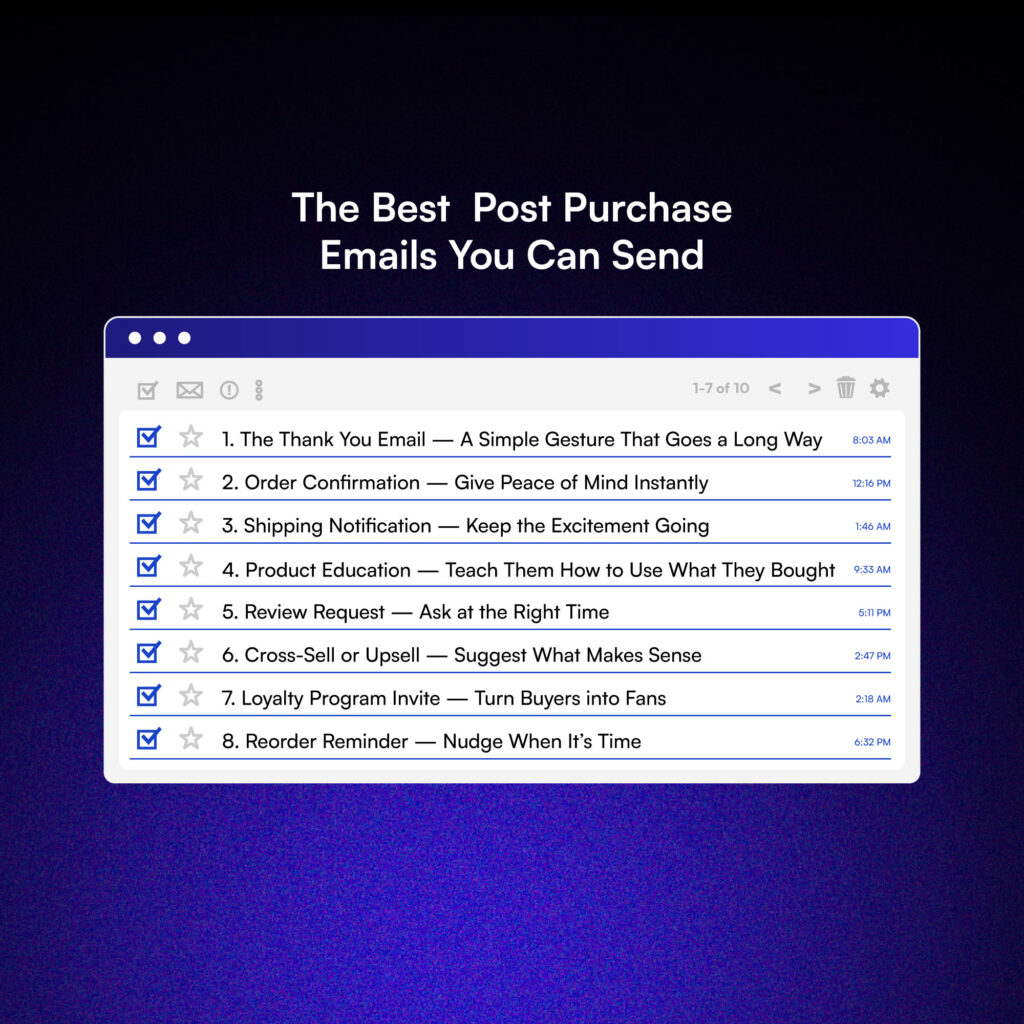
1. The Thank You Email: A Simple Gesture That Goes a Long Way
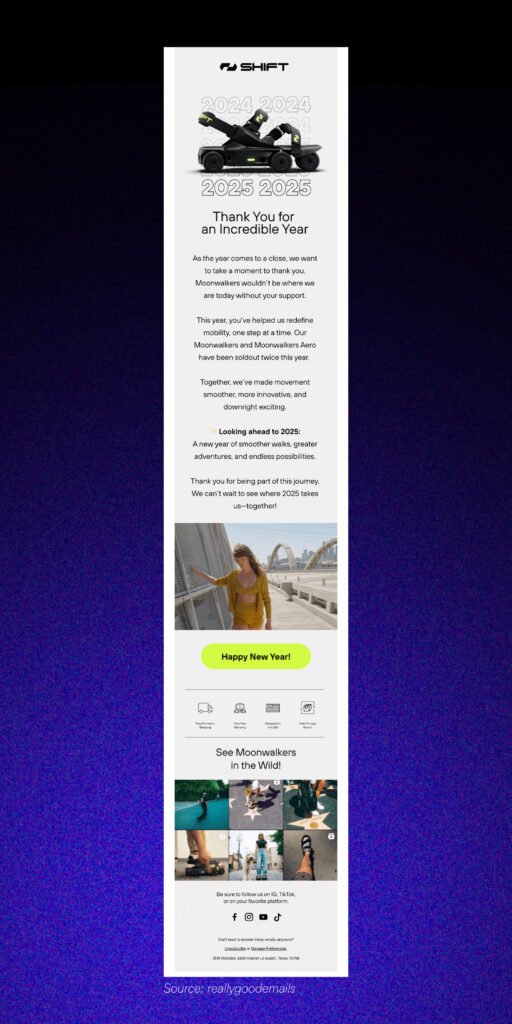
You might think a thank-you is implied in the sale, but sending it makes all the difference.
The thank-you email is your chance to make the customer feel valued beyond the transaction.
When done right, it deepens the emotional connection with your brand and reinforces their decision to buy.
This email should be warm, genuine, and customer-focused. Say more than just “Thanks for your order.” Try something like, “We’re so glad you chose us,” or “You just made our day.” Add a personal touch or a brand-specific message that doesn’t sound robotic.
Use this moment to:
- Show real appreciation
- Set expectations for what’s coming next
- Invite them to reach out if they have questions
Pro tip: Sign off with a real name (or team name) instead of a faceless “Do not reply.” It builds trust instantly.
2. Order Confirmation
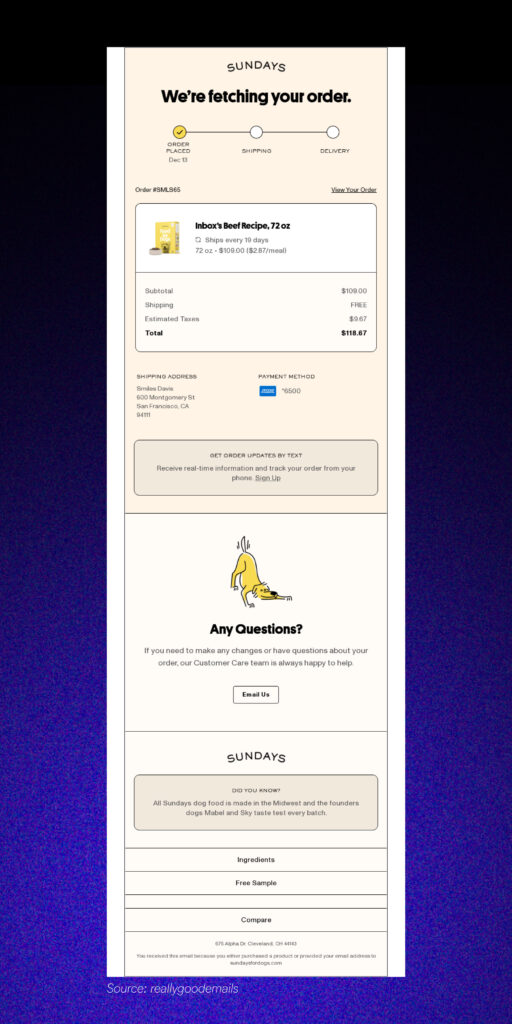
Once the excitement of checkout fades, most customers want one thing: reassurance.
The order confirmation email should deliver instant peace of mind. This is your moment to say, “We’ve got your order, and here’s everything you need to know.”
Include:
- A clear breakdown of what they bought (including size, color, quantity)
- Estimated delivery timelines
- Shipping address and payment method used
- A link to contact support in case something’s off
It’s not just about ticking boxes, it’s about removing friction. Make everything easy to scan and even easier to act on.
Pro tip: Add a CTA to “Track My Order” or link to an account portal where they can view their purchase history.
3. Shipping Notification to Keep the Excitement Going
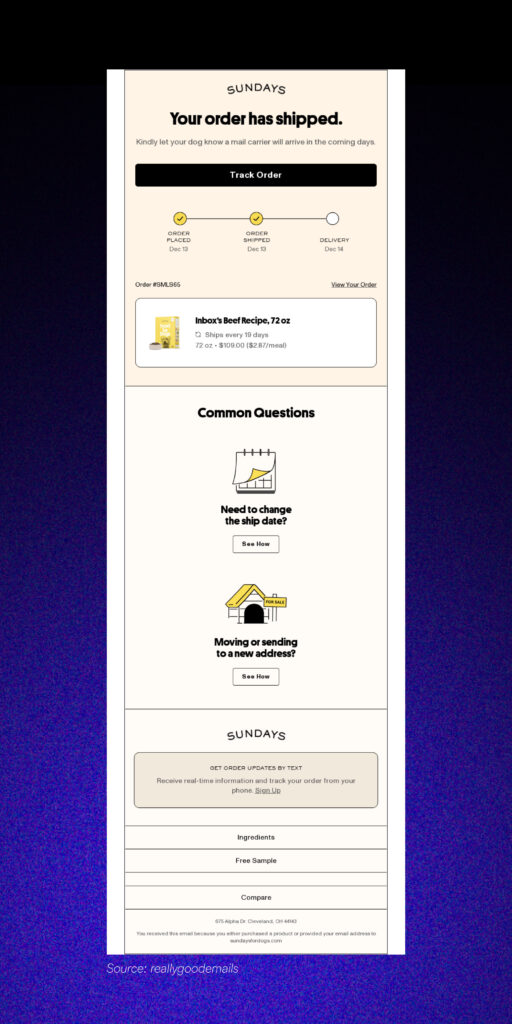
Your customer is officially in wait mode, and your shipping email should fuel the excitement, not stall it.
This email should provide the usual tracking details, but it’s also a great place to:
- Add a fun or branded message like “It’s on the way! Get excited!”
- Share tips on how to use the product once it arrives
- Recommend a complementary product while they wait
For example: “Your skincare set is en route! Want to get the most out of it? Here’s our quick-start guide,” followed by a link.
This kind of content gives customers something to engage with during the delivery window and keeps your brand top of mind.
Pro tip: Embed the tracking link directly in the email copy. No one wants to hunt for it.
4. Product Education to Teach Them How to Use What They Bought
The sale is the beginning of your customer’s experience with your product. So don’t leave them guessing.
Product education emails are your chance to ensure they know how to actually use what they just bought. This could be a quick-start guide, video tutorial, or best practices from your community.
Think of it as digital onboarding. Done well, this email reduces confusion, cuts down on support tickets, and lowers the chance of returns.
Even better? It boosts satisfaction and shows that you’re invested in their success, not just their money.
Example: “Here’s how to get the most out of your new diffuser, plus a quick 3-minute video to get you started.”
Pro tip: Use behavior-based triggers to send different guides for different products, so the content is always relevant.
5. Review Request to Ask at the Right Time
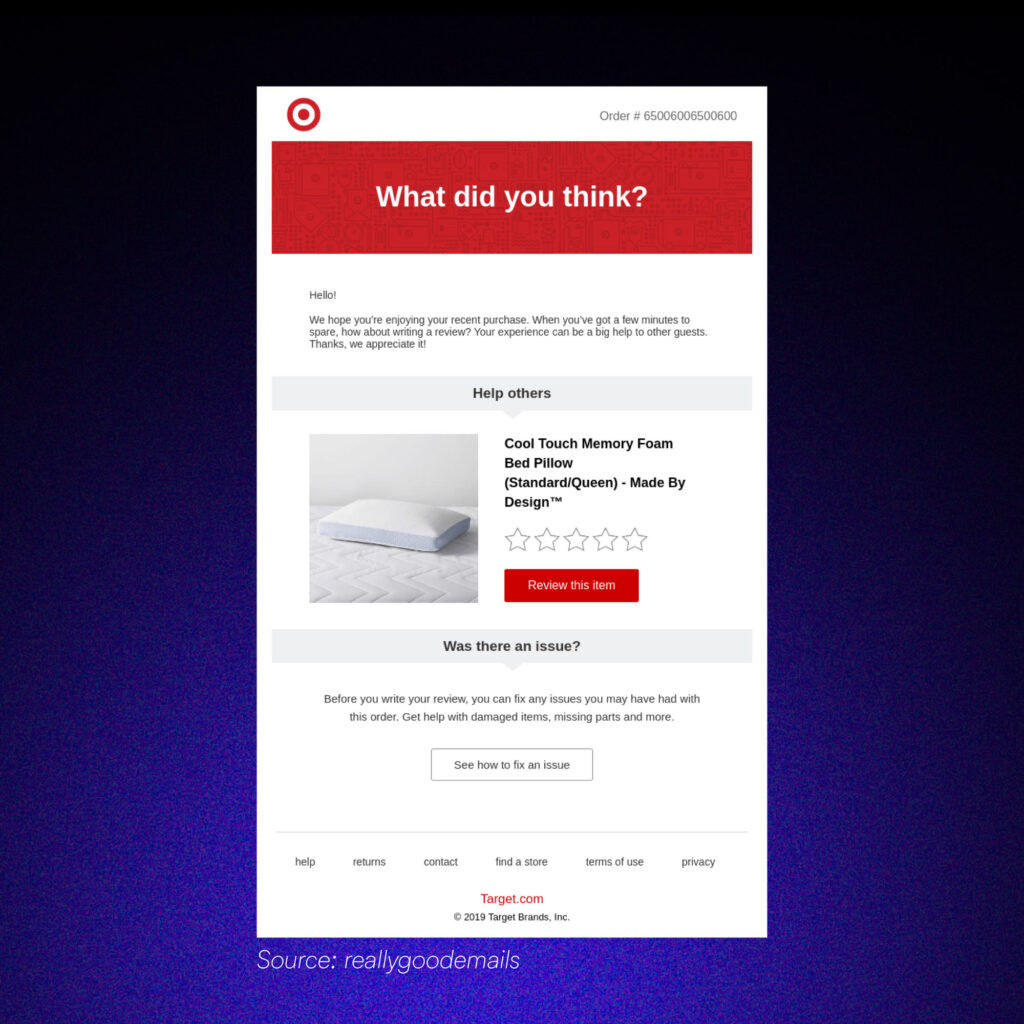
A good product review is more powerful than any ad you could run, but timing matters.
Wait until your customer has had a chance to use the product and form an opinion. Then, send a friendly nudge asking them to share their thoughts.
Keep it simple:
- Ask how everything’s going
- Include a direct link to leave a review
- Add a gentle reminder of how much their feedback helps others
Incentives can work, too, like offering a small discount on their next purchase. Just keep it low-pressure; this should feel like a conversation, not a transaction.
Example: “Loving your new backpack? We’d love a quick review—it only takes 30 seconds and helps other shoppers like you.”
Pro tip: Highlight one or two recent reviews in the email to show that others are engaging too.
6. Cross-Sell or Upsell to Suggest What Makes Sense
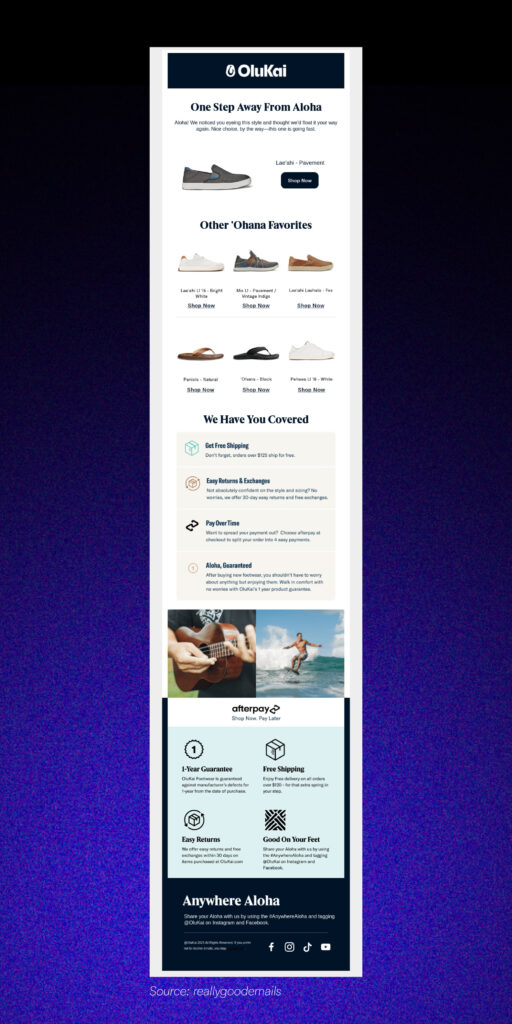
If your customers just bought something from you, they’re already engaged and more likely to buy again. But don’t blow it with a generic “You might also like…” list.
Smart upsell or cross-sell emails are personalized and helpful, not random or pushy.
Examples that feel right:
- “You picked up the ceramic pan. Want the matching lid?”
- “Your new running shoes are en route. Need some no-slip socks to go with them?”
Use their purchase data to recommend relevant items that enhance their experience, not clutter their cart.
Pro tip: Add product benefits or quick quotes from other buyers to make the recommendation feel organic and trustworthy.
7. Loyalty Program: Invite to Turn Buyers into Fans
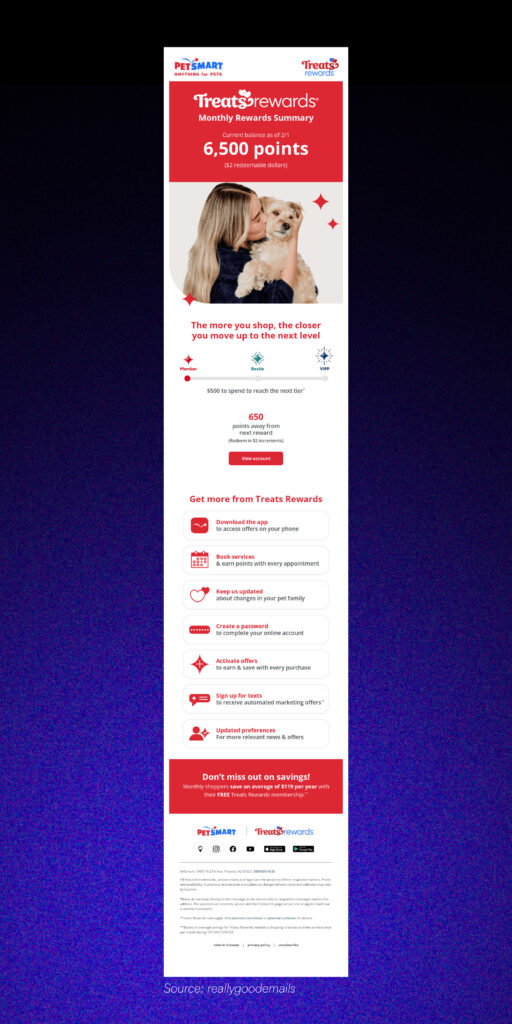
Your customer just trusted you enough to make a purchase; don’t let that momentum go to waste.
A well-timed loyalty program invite makes them feel like they’re getting something extra because they bought, not just because they’re on your list. Whether it’s points, perks, or early access to new drops, this email should feel more like a thank-you gift than a sales pitch.
Example: “Thanks for shopping with us! You’ve unlocked 100 bonus points, just for being awesome. Here’s how to turn them into rewards.”
Pro tip: Add social proof by showing how many others are already in the program or what exclusive benefits members are getting.
8. Reorder Reminder to Nudge When It’s Time
Some products are meant to be bought once. Others? They’re designed for repeat business, and a smart reorder email can bring them back at just the right time.
Great for:
- Consumables (like skincare, coffee, or supplements)
- Seasonal products (like holiday candles or gear)
- Subscription-like buying cycles
Frame it as a helpful heads-up rather than a push to buy.
Example: “Running low on your daily greens? Reorder now and stay stocked without the scramble.”
Pro tip: Let them reorder in one click; no need to dig through past emails or log in again.
Keep the Conversation Going, Not Just the Sales
Post-purchase emails are one of the most underused tools in e-commerce and one of the most powerful.
Why? Because they show up after trust has been built. Your customer said yes. Now’s your chance to turn that yes into long-term loyalty.
From a simple thank you to product education, review requests, and reorder nudges, every post-purchase email is an opportunity to add value, reinforce trust, and bring customers closer to your brand.
So stop thinking of these emails as “done deals.” Start thinking of them as the beginning of the relationship. And when you do that? You’re building a base of loyal, repeat customers who come back because they want to.

